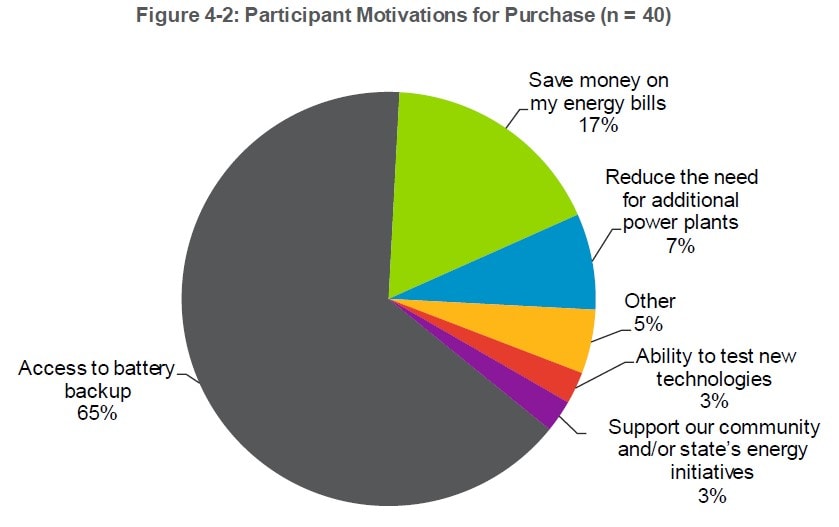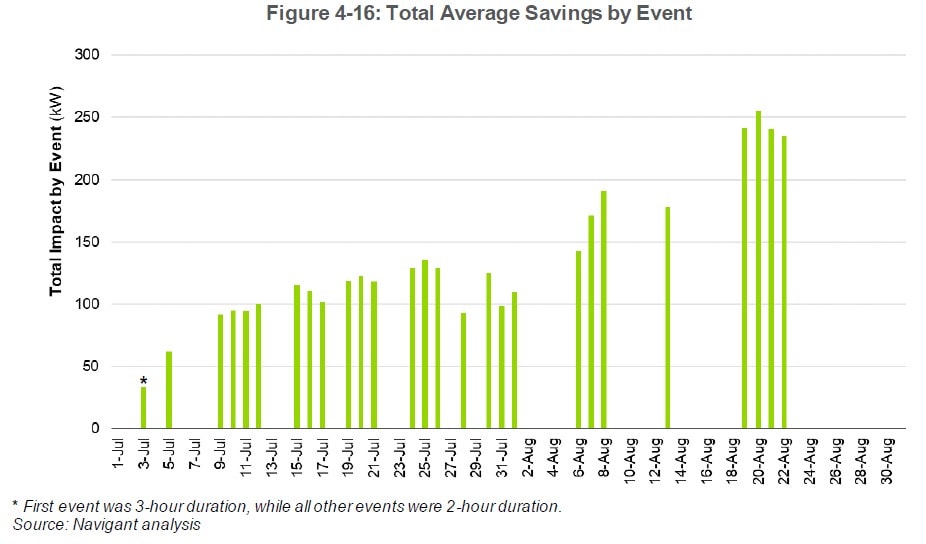ConnectedSolutions First Results: Massachusetts’ groundbreaking efficiency program for customer batteries receives its first report card
Last year, with technical support from Clean Energy Group (CEG), Massachusetts became the first state to officially incorporate behind-the-meter battery storage into its energy efficiency plan, and utilities began enrolling customers across the state in a groundbreaking pay-for-performance program. Now, preliminary results from this program, called ConnectedSolutions, have been published in a report from Navigant Consulting – and it appears, based on limited early enrollment data, that customer storage is a winner.
The report, titled “2019 Residential Energy Storage Demand Response Demonstration Evaluation – Summer Season,” was produced on behalf of utilities National Grid and Unitil. It provides a preview of the earliest results from those two utilities in Massachusetts and Rhode Island. Navigant used customer surveys as well as utility data to construct a picture of how the ConnectedSolutions program performed during the summer of 2019, and how participants felt about it. Although enrollment at that point was quite limited – some 65 households participated in National Grid’s territory, plus four households in Unitil’s territory – the report shows that customer batteries are being effectively used by the utility to reduce expensive regional demand peaks. It also shows that participating customers overwhelmingly like the program and plan to continue with it.
These results are important, and not just for one or two states. In the 18 months since Massachusetts adopted its battery program, the concept has spread across New England, with similar programs now offered in Rhode Island and Connecticut, and under consideration in New Hampshire. Meanwhile, Green Mountain Power in Vermont and Liberty Utilities in New Hampshire developed their own customer battery programs. Outside of New England, customer battery programs for peak demand reduction have been developed by PSEG on Long Island, Orange & Rockland Utilities in the northwestern suburbs of New York City, Portland General Electric and Oregon, and Sacramento Municipal Utility District and Southern California Edison in California.
Although not all these programs operate through state efficiency programs, they all embrace the same core concept that aggregated batteries behind customer meters can provide valuable utility services, benefiting all ratepayers while providing cost savings and resiliency to the homes and businesses that host them. The resiliency benefit to customers is particularly important given the current global pandemic – and was extremely important to customers even before the pandemic, as the Navigant report shows.
The ConnectedSolutions model, as implemented in Massachusetts, is not perfect. There are shortcomings in its design, among them the fact that it lacks provisions to encourage and support participation by low- and moderate-income customers, and does not provide added incentives for resilient systems that can support critical customer and community services during grid outages. However, it does represent a major new model for funding distributed storage and reducing dependence on fossil fuel peaker plants. As such, the preliminary results reported by Navigant are worth examining.
Findings
Customer Satisfaction
Among the findings of the Navigant report is that the ConnectedSolutions program is very popular with the participating residential customers. Ninety-seven percent of participating customers said they intended to continue to participate and would recommend the program to others.
This is an impressive approval rating, especially as compared with other, similar programs. For example, in 2017, National Grid announced that its two-year Smart Energy Solutions (SES) program, serving 11,000 customers in Worcester, MA, had achieved a customer satisfaction rate of 69 percent. The SES program, like ConnectedSolutions, rewards customers for lowering demand at peak times, but does so by adjusting thermostats and turning off appliances.
Utilities are now beginning to realize that customer batteries can provide the same load-reducing benefits as traditional demand response, but without negatively affecting the comfort and productivity of participants. And in addition, batteries provide customers with a valuable resilient power benefit, backing up their critical loads during power outages – something smart thermostats and appliances can’t do. As noted by Eversource and Unitil in a recent docket filing in New Hampshire, where the two utilities are proposing to replicate the Massachusetts ConnectedSolutions program, “Eversource and Unitil are proposing… incentives higher than other Direct Load Control offerings. This higher incentive assumes that storage performance does not impact customer comfort, will be more robust, more available, less likely to be overridden and thus more reliable as a resource overall.”
The importance of resiliency
The Navigant report confirmed that a large majority of participating customers – 65 percent – value backup power above other battery benefits and cited this as the primary reason why customers decided to install storage in their homes (see Figure 1). The second most valued benefit, cost savings, came in at 17 percent.

Figure 1: Participant motivations for battery purchase. Source: Navigant Consulting
This indicates that home batteries may enjoy a significant advantage over traditional energy efficiency and demand response measures, which cannot provide backup power in a grid outage. It also helps to explain how the ConnectedSolutions program is able to provide peak load reduction services to utilities at a relatively low cost: the program allows utilities to pay only for those battery services they actually receive, while customers are willing to make the initial investment because they understand that in addition to an eventual payback, they will also enjoy an immediate resiliency benefit. The ability of batteries to provide different services to different stakeholders allows utilities and customers to share the costs and benefits of a single device in a way that benefits both parties.
It is important to bear in mind that this result is based on surveys conducted in the fall of 2019, before the Covid-19 pandemic, and therefore does not reflect current added concerns about home health care in an era of mass quarantine and remote attendance at work and school. At least 2.5 million individuals in the U.S. rely on powered home health devices such as oxygen concentrators and nebulizers; the current pandemic – along with increased grid outages due to storms, wildfires and other natural disasters – has exposed the vulnerability of this home health population to grid outages. Not only that, but the pandemic is expected to result in slower recovery from grid outages caused by hurricanes and other natural disasters. In the current climate, it is probably safe to assume that backup power has become even more important to many people than it previously was.
Participation in peak-reducing events
Utilities pay ConnectedSolutions customers for the load reductions their home batteries can provide during costly regional load peaks. The program does not require participants to respond to every event signaled by the utility, although the customer payoff is reduced if customers opt out of events. The Navigant report found that enrollee participation was quite high: 94 percent of participants never opted out of an event.
However, average performance – measured in terms of the percentage of overall battery capacity discharged during peak shaving events – was lower. The study found that two-thirds of the batteries enrolled successfully performed in every event they participated in, and 90 percent successfully performed in more than 60 percent of the events they participated in; but “successful performance” is a fairly low bar, being defined by Navigant as a battery discharging more than 20 percent of its maximum capacity during an event. The study also notes that two batteries failed to successfully respond throughout the season. Overall, the average savings for any event represented 64 percent of the available aggregated battery capacity.
According to the report, this reduced average response is likely due to combination of factors, including some battery customers opting out of some events, some customers reserving a portion of their battery capacity for backup power in case of an outage, and some batteries not being completely charged prior to events, which would reduce their ability to respond. Other possible causes include inverter efficiency losses, or device settings that differ from assumptions in the calculation of maximum expected discharge.
Investigating these and other possible causes of low average battery response is a recommendation of the report.
Customer payments
Participating customers are paid seasonally based on their average discharge across all event hours in the season. For the summer 2019 season, Navigant reports that the average residential customer battery discharge was 5.5 kW. Given the summer payment rate of $225/kW, this means the average customer in the program would have earned $1,237.5 for the summer season, or $12,375 per customer over a 10-year period (assuming performance levels and payment rates held steady). Adding in the less lucrative winter program, annual payments rise to $1,512.50, or $15,125 over ten years (residential winter rates are $50/kW in the Massachusetts National Grid territory).
One way to gauge the economic attractiveness of the program to potential enrollees is to look at the battery payback period. If a customer were to participate in both the summer and winter programs, based on the reported average discharge, performance payments would average out to $126/month. This more than offsets the monthly loan service payment of $119 the customer would make if he or she took advantage of the Massachusetts HEAT loan program, which offers zero interest loans for energy efficiency improvements, with a seven-year payback period. Again, assuming an installed cost of $10,000 for a battery, the customer could pay off the loan in year six using the performance payments. After that, any additional revenues from participation in ConnectedSolutions would offset the customer’s electric bill (the average monthly residential electric bill in Massachusetts is $131).
These numbers are based on participation in ConnectedSolutions alone. In reality, if Massachusetts customers install storage with solar, they can also qualify for a SMART solar incentive with an additional storage adder.
One aspect of ConnectedSolutions that needs improvement – and is not addressed in the Navigant report – is the lack of provisions for low income customer participation. This issue was raised by CEG when the program was being developed, but despite the assurances of utility administrators, no added incentives for low income customers (or for commercial facilities in underserved neighborhoods) were included in this first version of the program. Developers face higher risk and cost barriers in low-income neighborhoods, so if low- and -middle-income customers are not to be left behind in the roll-out of distributed energy storage, ConnectedSolutions and similar programs must include both carve-outs for LMI participants, and additional incentives to encourage their participation. These important elements should be included when ConnectedSolutions is updated for the 2022-2024 Massachusetts energy efficiency plan.
Program effectiveness
The ConnectedSolutions program is intended to reward customers for lending their battery capacity to utilities, for the purpose of reducing expensive and polluting regional electric demand peaks. Ultimately, its success will be judged on how effectively it achieves this.
The cumulative impact of National Grid’s ConnectedSolutions program in the 2019 summer season is shown in Figure 2. The reason for the increase over time is that more customers enrolled as the season progressed.

Figure 2: Total average savings by event. Source: Navigant Consulting
This chart shows that by the end of the 2019 summer season, with 63 customers enrolled, the program resulted in an average peak demand reduction of about 250 kW, or one-quarter of a megawatt, per event. If the utility continues to call about the same number of events next summer (27), assuming program enrollment and level of participation remained constant, this would amount to about 6.75 MW of peak demand reduction for the season, for residential participants in National Grid territory alone. This amount understates overall program results for the season, since it does not include commercial participants, nor does it include results from other utility territories. Since the utilities continue to enroll more customers, and recently applied to the Massachusetts Department of Public Utilities to expand the ConnectedSolutions program, it is likely that program results will continue to grow over time.
To put this in perspective, there are currently approximately 23 fossil fuel “peaker” plants operational in Massachusetts. These plants burn natural gas, oil and kerosene, and are practically unregulated due to their size (many are under 20 MW in capacity). They earn millions of dollars each year but only operate around 7 percent of the hours each year; and they are frequently sited in low-income urban environments. Distributed energy storage, aggregated and dispatched on peak hours, provides the same service as these fossil fuel peakers, but without the pollution. Solar+storage also provides resiliency benefits, helps to integrate renewables, and saves money for customers – all benefits that fossil fuel peakers do not provide.
In addition to the existing fossil fuel peaker plants, there are many more proposed peakers in the New England ISO interconnection queue. This represents a great opportunity for clean solar PV and energy storage to replace these plants, if state can bring these technologies to scale quickly. Expanding the ConnectedSolutions program is a great tool to achieve this.
Lessons learned
As ConnectedSolutions and related “bring-your-own-device” customer battery programs spread and are replicated in more states and utility territories, more results will emerge, creating opportunities to improve program designs based on lessons learned. The Navigant report is a modest first effort; nevertheless, it provides some recommendations for improving program implementation. For National Grid, there are two main recommendations in the report:
- Backup power: Communicate to customers that the utility recognizes the importance of backup power for their homes and businesses; establish a recommended battery reserve level for customers to maintain for this purpose; and make sure customers understand that battery discharge events will not be called prior to storms that could cause grid outages, to ensure customers get the maximum possible resilience benefit when it is needed. This may help to increase customer enrollment in the program.
- Battery tracking and performance: Improve telemetry systems so utilities have better information about customer batteries; improve understanding of why some batteries underperformed; improve tracking of customer participation; monitor and troubleshoot underperforming batteries. This should help to improve average battery response to peak demand events.
To these recommendations, CEG would add:
- Expand ConnectedSolutions: The program should have more money devoted to it and should be more actively marketed to customers by all public utilities in the Commonwealth, as well as by third-party aggregators. A proposed daily dispatch program should be added as an alternative to the current “targeted dispatch” model.
- Add low income provisions: ConnectedSolutions should include an LMI carve-out, to ensure that some portion of program funds are allocated in underserved communities; and it should include an LMI adder, to help developers in these communities overcome barriers.
- Add resiliency provisions: In addition to recognizing the importance customers place on resiliency, the program administrators should also recognize that making solar+storage systems “islandable” (able to support host facility loads during a grid outage) involves an added expense for the customer – but it also helps the utility by reducing impacts from grid outages. In order to help customers achieve this benefit, a resiliency adder should be offered through the program.
CEG will continue to track the New England ConnectedSolution programs as they expand; support their replication in other states; and advocate for needed improvements.
Todd Olinsky-Paul is a senior project director at Clean Energy Group and the Clean Energy States Alliance. He directs CEG’s energy storage policy effort in Massachusetts and the New England states. CEG wishes to thank Barr Foundation and Merck Family Fund for their support for this work.
Published On
July 20, 2020

